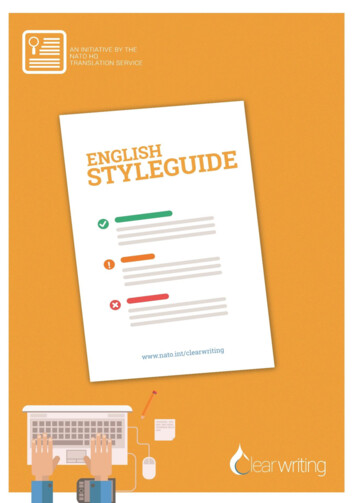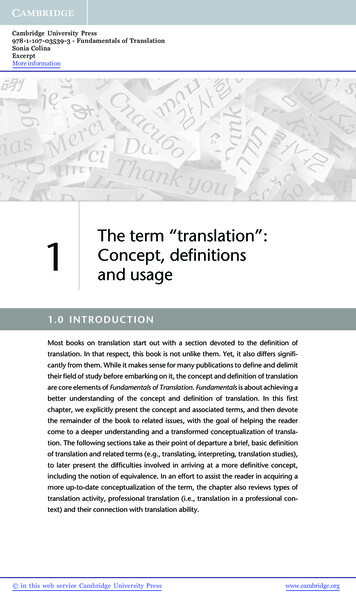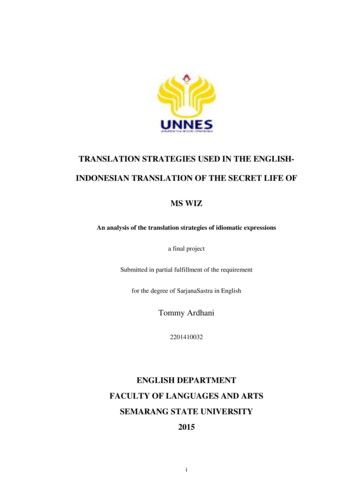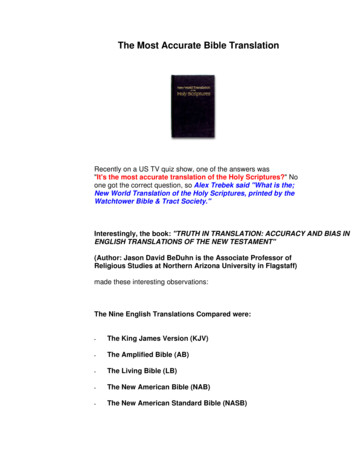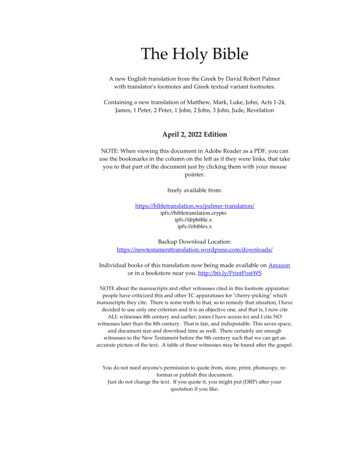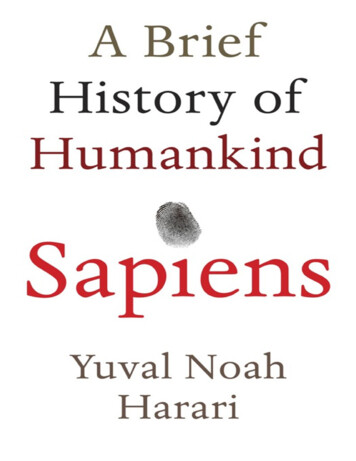
Transcription
English translation copyright 2014 by Yuval Noah HarariCloth edition published 2014Published simultaneously in the United Kingdom by Harvill Secker First published in Hebrew in Israel in 2011 byKinneret, Zmora-Bitan, DvirSignal Books is an imprint of McClelland & Stewart, a division of Random House of Canada Limited, a PenguinRandom House CompanyAll rights reserved. The use of any part of this publication reproduced, transmitted in any form or by any means,electronic, mechanical, photocopying, recording, or otherwise, or stored in a retrieval system, without the priorwritten consent of the publisher – or, in case of photocopying or other reprographic copying, a licence from theCanadian Copyright Licensing Agency – is an infringement of the copyright law.Library and Archives Canada Cataloguing in PublicationHarari, Yuval N., authorSapiens : a brief history of humankind / Yuval Noah Harari.Includes bibliographical references.ISBN 978-0-7710-3850-1 (bound).–ISBN 978-0-7710-3852-5 (html)1. Civilization–History. 2. Human beings–History. I. Title.CB25.H37 2014 909 C2014-904589-1C2014-904590-5Jacket design Suzanne DeanPicture research by Caroline WoodMaps by Neil GowerMcClelland & Stewart,a division of Random House of Canada Limited,a Penguin Random House Companywww.randomhouse.cav3.1
In loving memory of my father, Shlomo Harari
ContentsCoverTitle PageCopyrightDedicationTimeline of HistoryPart One The Cognitive Revolution1 An Animal of No Significance2 The Tree of Knowledge3 A Day in the Life of Adam and Eve4 The FloodPart Two The Agricultural Revolution5 History’s Biggest Fraud6 Building Pyramids7 Memory Overload8 There is No Justice in HistoryPart Three The Unification of Humankind9 The Arrow of History10 The Scent of Money11 Imperial Visions12 The Law of Religion13 The Secret of SuccessPart Four The Scientific Revolution14 The Discovery of Ignorance15 The Marriage of Science and Empire16 The Capitalist Creed17 The Wheels of Industry
18 A Permanent Revolution19 And They Lived Happily Ever After20 The End of Homo SapiensAfterword:The Animal that Became a GodNotesAcknowledgementsImage credits
Timeline of HistoryYearsBeforethePresent13.5Matter and energy appear. Beginning of physics. Atoms and moleculesbillion appear. Beginning of ormation of planet Earth.Emergence of organisms. Beginning of biology.Last common grandmother of humans and chimpanzees.Evolution of the genus Homo in Africa. First stone tools.Humans spread from Africa to Eurasia. Evolution of different humanmillion species.500,000 Neanderthals evolve in Europe and the Middle East.300,000 Daily usage of fire.200,000 Homo sapiens evolves in East Africa.70,000The Cognitive Revolution. Emergence of fictive language.Beginning of history. Sapiens spread out of Africa.45,000 Sapiens settle Australia. Extinction of Australian megafauna.30,000 Extinction of Neanderthals.
16,000 Sapiens settle America. Extinction of American megafauna.13,00012,000Extinction of Homo floresiensis. Homo sapiens the only surviving humanspecies.The Agricultural Revolution. Domestication of plants and animals.Permanent settlements.5,000First kingdoms, script and money. Polytheistic religions.4,250First empire – the Akkadian Empire of Sargon.Invention of coinage – a universal money.The Persian Empire – a universal political order ‘for the benefit of all2,500humans’.Buddhism in India – a universal truth ‘to liberate all beings fromsuffering’.2,000Han Empire in China. Roman Empire in the Mediterranean. Christianity.1,400Islam.The Scientific Revolution. Humankind admits its ignorance and begins to500acquire unprecedented power. Europeans begin to conquer America andthe oceans. The entire planet becomes a single historical arena. The riseof capitalism.200ThePresentTheThe Industrial Revolution. Family and community are replaced by stateand market. Massive extinction of plants and animals.Humans transcend the boundaries of planet Earth. Nuclear weaponsthreaten the survival of humankind. Organisms are increasingly shapedby intelligent design rather than natural selection.Intelligent design becomes the basic principle of life? Homo sapiens isFuture replaced by superhumans?
Part OneThe Cognitive Revolution1. A human handprint made about 30,000 years ago, on the wall of the Chauvet-Pont-d’Arc Cave insouthern France. Somebody tried to say, ‘I was here!’
1An Animal of No SignificanceABOUT 13.5 BILLION YEARS AGO, MATTER, energy, time and space came intobeing in what is known as the Big Bang. The story of these fundamental featuresof our universe is called physics.About 300,000 years after their appearance, matter and energy started tocoalesce into complex structures, called atoms, which then combined intomolecules. The story of atoms, molecules and their interactions is called chemistry.About 3.8 billion years ago, on a planet called Earth, certain moleculescombined to form particularly large and intricate structures called organisms. Thestory of organisms is called biology.About 70,000 years ago, organisms belonging to the species Homo sapiensstarted to form even more elaborate structures called cultures. The subsequentdevelopment of these human cultures is called history.Three important revolutions shaped the course of history: the CognitiveRevolution kick-started history about 70,000 years ago. The AgriculturalRevolution sped it up about 12,000 years ago. The Scienti c Revolution, which gotunder way only 500 years ago, may well end history and start somethingcompletely di erent. This book tells the story of how these three revolutions haveaffected humans and their fellow organisms.There were humans long before there was history. Animals much like modernhumans rst appeared about 2.5 million years ago. But for countless generationsthey did not stand out from the myriad other organisms with which they sharedtheir habitats.On a hike in East Africa 2 million years ago, you might well have encountered afamiliar cast of human characters: anxious mothers cuddling their babies andclutches of carefree children playing in the mud; temperamental youths cha ngagainst the dictates of society and weary elders who just wanted to be left inpeace; chest-thumping machos trying to impress the local beauty and wise oldmatriarchs who had already seen it all. These archaic humans loved, played,formed close friendships and competed for status and power – but so didchimpanzees, baboons and elephants. There was nothing special about them.
Nobody, least of all humans themselves, had any inkling that their descendantswould one day walk on the moon, split the atom, fathom the genetic code andwrite history books. The most important thing to know about prehistoric humansis that they were insigni cant animals with no more impact on their environmentthan gorillas, fireflies or jellyfish.Biologists classify organisms into species. Animals are said to belong to thesame species if they tend to mate with each other, giving birth to fertile o spring.Horses and donkeys have a recent common ancestor and share many physicaltraits. But they show little sexual interest in one another. They will mate ifinduced to do so – but their o spring, called mules, are sterile. Mutations indonkey DNA can therefore never cross over to horses, or vice versa. The two typesof animals are consequently considered two distinct species, moving alongseparate evolutionary paths. By contrast, a bulldog and a spaniel may look verydi erent, but they are members of the same species, sharing the same DNA pool.They will happily mate and their puppies will grow up to pair o with other dogsand produce more puppies.Species that evolved from a common ancestor are bunched together under theheading ‘genus’ (plural genera). Lions, tigers, leopards and jaguars are di erentspecies within the genus Panthera. Biologists label organisms with a two-part Latinname, genus followed by species. Lions, for example, are called Panthera leo, thespecies leo of the genus Panthera. Presumably, everyone reading this book is aHomo sapiens – the species sapiens (wise) of the genus Homo (man).Genera in their turn are grouped into families, such as the cats (lions, cheetahs,house cats), the dogs (wolves, foxes, jackals) and the elephants (elephants,mammoths, mastodons). All members of a family trace their lineage back to afounding matriarch or patriarch. All cats, for example, from the smallest housekitten to the most ferocious lion, share a common feline ancestor who lived about25 million years ago.Homo sapiens, too, belongs to a family. This banal fact used to be one ofhistory’s most closely guarded secrets. Homo sapiens long preferred to view itselfas set apart from animals, an orphan bereft of family, lacking siblings or cousins,and most importantly, without parents. But that’s just not the case. Like it or not,we are members of a large and particularly noisy family called the great apes.Our closest living relatives include chimpanzees, gorillas and orang-utans. Thechimpanzees are the closest. Just 6 million years ago, a single female ape had twodaughters. One became the ancestor of all chimpanzees, the other is our owngrandmother.
Skeletons in the ClosetHomo sapiens has kept hidden an even more disturbing secret. Not only do wepossess an abundance of uncivilised cousins, once upon a time we had quite a fewbrothers and sisters as well. We are used to thinking about ourselves as the onlyhumans, because for the last 10,000 years, our species has indeed been the onlyhuman species around. Yet the real meaning of the word human is ‘an animalbelonging to the genus Homo’, and there used to be many other species of thisgenus besides Homo sapiens. Moreover, as we shall see in the last chapter of thebook, in the not so distant future we might again have to contend with nonsapiens humans. To clarify this point, I will often use the term ‘Sapiens’ to denotemembers of the species Homo sapiens, while reserving the term ‘human’ to refer toall extant members of the genus Homo.Humans rst evolved in East Africa about 2.5 million years ago from an earliergenus of apes called Australopithecus, which means ‘Southern Ape’. About 2 millionyears ago, some of these archaic men and women left their homeland to journeythrough and settle vast areas of North Africa, Europe and Asia. Since survival inthe snowy forests of northern Europe required di erent traits than those needed tostay alive in Indonesia’s steaming jungles, human populations evolved in di erentdirections. The result was several distinct species, to each of which scientists haveassigned a pompous Latin name.2. Our siblings, according to speculative reconstructions (left to right):Homo rudolfensis (East Africa); Homo erectus (East Asia); and Homo neanderthalensis (Europe andwestern Asia). All are humans.Humans in Europe and western Asia evolved into Homo neanderthalensis (‘Man
from the Neander Valley), popularly referred to simply as ‘Neanderthals’.Neanderthals, bulkier and more muscular than us Sapiens, were well adapted tothe cold climate of Ice Age western Eurasia. The more eastern regions of Asia werepopulated by Homo erectus, ‘Upright Man’, who survived there for close to 2million years, making it the most durable human species ever. This record isunlikely to be broken even by our own species. It is doubtful whether Homosapiens will still be around a thousand years from now, so 2 million years is reallyout of our league.On the island of Java, in Indonesia, lived Homo soloensis, ‘Man from the SoloValley’, who was suited to life in the tropics. On another Indonesian island – thesmall island of Flores – archaic humans underwent a process of dwar ng. Humansrst reached Flores when the sea level was exceptionally low, and the island waseasily accessible from the mainland. When the seas rose again, some people weretrapped on the island, which was poor in resources. Big people, who need a lot offood, died rst. Smaller fellows survived much better. Over the generations, thepeople of Flores became dwarves. This unique species, known by scientists asHomo oresiensis, reached a maximum height of only one metre and weighed nomore than twenty- ve kilograms. They were nevertheless able to produce stonetools, and even managed occasionally to hunt down some of the island’s elephants– though, to be fair, the elephants were a dwarf species as well.In 2010 another lost sibling was rescued from oblivion, when scientistsexcavating the Denisova Cave in Siberia discovered a fossilised nger bone.Genetic analysis proved that the nger belonged to a previously unknown humanspecies, which was named Homo denisova. Who knows how many lost relatives ofours are waiting to be discovered in other caves, on other islands, and in otherclimes.While these humans were evolving in Europe and Asia, evolution in East Africadid not stop. The cradle of humanity continued to nurture numerous new species,such as Homo rudolfensis, ‘Man from Lake Rudolf’, Homo ergaster, ‘Working Man’,and eventually our own species, which we’ve immodestly named Homo sapiens,‘Wise Man’.The members of some of these species were massive and others were dwarves.Some were fearsome hunters and others meek plant-gatherers. Some lived only ona single island, while many roamed over continents. But all of them belonged tothe genus Homo. They were all human beings.It’s a common fallacy to envision these species as arranged in a straight line ofdescent, with Ergaster begetting Erectus, Erectus begetting the Neanderthals, andthe Neanderthals evolving into us. This linear model gives the mistakenimpression that at any particular moment only one type of human inhabited theearth, and that all earlier species were merely older models of ourselves. The truth
is that from about 2 million years ago until around 10,000 years ago, the worldwas home, at one and the same time, to several human species. And why not?Today there are many species of foxes, bears and pigs. The earth of a hundredmillennia ago was walked by at least six di erent species of man. It’s our currentexclusivity, not that multi-species past, that is peculiar – and perhapsincriminating. As we will shortly see, we Sapiens have good reasons to repress thememory of our siblings.The Cost of ThinkingDespite their many di erences, all human species share several de ningcharacteristics. Most notably, humans have extraordinarily large brains comparedto other animals. Mammals weighing sixty kilograms have an average brain sizeof 200 cubic centimetres. The earliest men and women, 2.5 million years ago, hadbrains of about 600 cubic centimetres. Modern Sapiens sport a brain averaging1,200–1,400 cubic centimetres. Neanderthal brains were even bigger.That evolution should select for larger brains may seem to us like, well, a nobrainer. We are so enamoured of our high intelligence that we assume that whenit comes to cerebral power, more must be better. But if that were the case, thefeline family would also have produced cats who could do calculus. Why is genusHomo the only one in the entire animal kingdom to have come up with suchmassive thinking machines?The fact is that a jumbo brain is a jumbo drain on the body. It’s not easy tocarry around, especially when encased inside a massive skull. It’s even harder tofuel. In Homo sapiens, the brain accounts for about 2–3 per cent of total bodyweight, but it consumes 25 per cent of the body’s energy when the body is at rest.By comparison, the brains of other apes require only 8 per cent of rest-timeenergy. Archaic humans paid for their large brains in two ways. Firstly, they spentmore time in search of food. Secondly, their muscles atrophied. Like a governmentdiverting money from defence to education, humans diverted energy from bicepsto neurons. It’s hardly a foregone conclusion that this is a good strategy forsurvival on the savannah. A chimpanzee can’t win an argument with a Homosapiens, but the ape can rip the man apart like a rag doll.Today our big brains pay o nicely, because we can produce cars and guns thatenable us to move much faster than chimps, and shoot them from a safe distanceinstead of wrestling. But cars and guns are a recent phenomenon. For more than 2million years, human neural networks kept growing and growing, but apart fromsome int knives and pointed sticks, humans had precious little to show for it.
What then drove forward the evolution of the massive human brain during those 2million years? Frankly, we don’t know.Another singular human trait is that we walk upright on two legs. Standing up,it’s easier to scan the savannah for game or enemies, and arms that areunnecessary for locomotion are freed for other purposes, like throwing stones orsignalling. The more things these hands could do, the more successful their ownerswere, so evolutionary pressure brought about an increasing concentration ofnerves and nely tuned muscles in the palms and ngers. As a result, humans canperform very intricate tasks with their hands. In particular, they can produce anduse sophisticated tools. The rst evidence for tool production dates from about 2.5million years ago, and the manufacture and use of tools are the criteria by whicharchaeologists recognise ancient humans.Yet walking upright has its downside. The skeleton of our primate ancestorsdeveloped for millions of years to support a creature that walked on all fours andhad a relatively small head. Adjusting to an upright position was quite achallenge, especially when the sca olding had to support an extra-large cranium.Humankind paid for its lofty vision and industrious hands with backaches and stinecks.Women paid extra. An upright gait required narrower hips, constricting thebirth canal – and this just when babies’ heads were getting bigger and bigger.Death in childbirth became a major hazard for human females. Women who gavebirth earlier, when the infants brain and head were still relatively small andsupple, fared better and lived to have more children. Natural selectionconsequently favoured earlier births. And, indeed, compared to other animals,humans are born prematurely, when many of their vital systems are still underdeveloped. A colt can trot shortly after birth; a kitten leaves its mother to forageon its own when it is just a few weeks old. Human babies are helpless, dependentfor many years on their elders for sustenance, protection and education.This fact has contributed greatly both to humankind’s extraordinary socialabilities and to its unique social problems. Lone mothers could hardly forageenough food for their o spring and themselves with needy children in tow.Raising children required constant help from other family members andneighbours. It takes a tribe to raise a human. Evolution thus favoured thosecapable of forming strong social ties. In addition, since humans are bornunderdeveloped, they can be educated and socialised to a far greater extent thanany other animal. Most mammals emerge from the womb like glazed earthenwareemerging from a kiln – any attempt at remoulding will scratch or break them.Humans emerge from the womb like molten glass from a furnace. They can bespun, stretched and shaped with a surprising degree of freedom. This is why todaywe can educate our children to become Christian or Buddhist, capitalist or
socialist, warlike or peace-loving.*We assume that a large brain, the use of tools, superior learning abilities andcomplex social structures are huge advantages. It seems self-evident that thesehave made humankind the most powerful animal on earth. But humans enjoyedall of these advantages for a full 2 million years during which they remained weakand marginal creatures. Thus humans who lived a million years ago, despite theirbig brains and sharp stone tools, dwelt in constant fear of predators, rarelyhunted large game, and subsisted mainly by gathering plants, scooping up insects,stalking small animals, and eating the carrion left behind by other more powerfulcarnivores.One of the most common uses of early stone tools was to crack open bones inorder to get to the marrow. Some researchers believe this was our original niche.Just as woodpeckers specialise in extracting insects from the trunks of trees, therst humans specialised in extracting marrow from bones. Why marrow? Well,suppose you observe a pride of lions take down and devour a gira e. You waitpatiently until they’re done. But it’s still not your turn because first the hyenas andjackals – and you don’t dare interfere with them scavenge the leftovers. Only thenwould you and your band dare approach the carcass, look cautiously left and right– and dig into the edible tissue that remained.This is a key to understanding our history and psychology. Genus Homo’sposition in the food chain was, until quite recently, solidly in the middle. Formillions of years, humans hunted smaller creatures and gathered what they could,all the while being hunted by larger predators. It was only 400,000 years ago thatseveral species of man began to hunt large game on a regular basis, and only inthe last 100,000 years – with the rise of Homo sapiens – that man jumped to thetop of the food chain.That spectacular leap from the middle to the top had enormous consequences.Other animals at the top of the pyramid, such as lions and sharks, evolved intothat position very gradually, over millions of years. This enabled the ecosystem todevelop checks and balances that prevent lions and sharks from wreaking toomuch havoc. As lions became deadlier, so gazelles evolved to run faster, hyenas tocooperate better, and rhinoceroses to be more bad-tempered. In contrast,humankind ascended to the top so quickly that the ecosystem was not given timeto adjust. Moreover, humans themselves failed to adjust. Most top predators of theplanet are majestic creatures. Millions of years of dominion have lled them withself-con dence. Sapiens by contrast is more like a banana republic dictator.
Having so recently been one of the underdogs of the savannah, we are full of fearsand anxieties over our position, which makes us doubly cruel and dangerous.Many historical calamities, from deadly wars to ecological catastrophes, haveresulted from this over-hasty jump.A Race of CooksA signi cant step on the way to the top was the domestication of re. Somehuman species may have made occasional use of re as early as 800,000 yearsago. By about 300,000 years ago, Homo erectus, Neanderthals and the forefathersof Homo sapiens were using re on a daily basis. Humans now had a dependablesource of light and warmth, and a deadly weapon against prowling lions. Notlong afterwards, humans may even have started deliberately to torch theirneighbourhoods. A carefully managed re could turn impassable barren thicketsinto prime grasslands teeming with game. In addition, once the re died down,Stone Age entrepreneurs could walk through the smoking remains and harvestcharcoaled animals, nuts and tubers.But the best thing re did was cook. Foods that humans cannot digest in theirnatural forms – such as wheat, rice and potatoes – became staples of our dietthanks to cooking. Fire not only changed food’s chemistry, it changed its biologyas well. Cooking killed germs and parasites that infested food. Humans also had afar easier time chewing and digesting old favourites such as fruits, nuts, insectsand carrion if they were cooked. Whereas chimpanzees spend ve hours a daychewing raw food, a single hour suffices for people eating cooked food.The advent of cooking enabled humans to eat more kinds of food, to devote lesstime to eating, and to make do with smaller teeth and shorter intestines. Somescholars believe there is a direct link between the advent of cooking, theshortening of the human intestinal track, and the growth of the human brain.Since long intestines and large brains are both massive energy consumers, it’shard to have both. By shortening the intestines and decreasing their energyconsumption, cooking inadvertently opened the way to the jumbo brains ofNeanderthals and Sapiens.1Fire also opened the rst signi cant gulf between man and the other animals.The power of almost all animals depends on their bodies: the strength of theirmuscles, the size of their teeth, the breadth of their wings. Though they mayharness winds and currents, they are unable to control these natural forces, andare always constrained by their physical design. Eagles, for example, identifythermal columns rising from the ground, spread their giant wings and allow the
hot air to lift them upwards. Yet eagles cannot control the location of the columns,and their maximum carrying capacity is strictly proportional to their wingspan.When humans domesticated re, they gained control of an obedient andpotentially limitless force. Unlike eagles, humans could choose when and where toignite a ame, and they were able to exploit re for any number of tasks. Mostimportantly, the power of fire was not limited by the form, structure or strength ofthe human body. A single woman with a int or re stick could burn down anentire forest in a matter of hours. The domestication of re was a sign of things tocome.Our Brothers’ KeepersDespite the bene ts of re, 150,000 years ago humans were still marginalcreatures. They could now scare away lions, warm themselves during cold nights,and burn down the occasional forest. Yet counting all species together, there werestill no more than perhaps a million humans living between the Indonesianarchipelago and the Iberian peninsula, a mere blip on the ecological radar.Our own species, Homo sapiens, was already present on the world stage, but sofar it was just minding its own business in a corner of Africa. We don’t knowexactly where and when animals that can be classi ed as Homo sapiens rstevolved from some earlier type of humans, but most scientists agree that by150,000 years ago, East Africa was populated by Sapiens that looked just like us.If one of them turned up in a modern morgue, the local pathologist would noticenothing peculiar. Thanks to the blessings of re, they had smaller teeth and jawsthan their ancestors, whereas they had massive brains, equal in size to ours.Scientists also agree that about 70,000 years ago, Sapiens from East Africaspread into the Arabian peninsula, and from there they quickly overran the entireEurasian landmass.When Homo sapiens landed in Arabia, most of Eurasia was already settled byother humans. What happened to them? There are two con icting theories. The‘Interbreeding Theory’ tells a story of attraction, sex and mingling. As the Africanimmigrants spread around the world, they bred with other human populations,and people today are the outcome of this interbreeding.For example, when Sapiens reached the Middle East and Europe, theyencountered the Neanderthals. These humans were more muscular than Sapiens,had larger brains, and were better adapted to cold climes. They used tools andre, were good hunters, and apparently took care of their sick and in rm.(Archaeologists have discovered the bones of Neanderthals who lived for many
years with severe physical handicaps, evidence that they were cared for by theirrelatives.) Neanderthals are often depicted in caricatures as the archetypicalbrutish and stupid ‘cave people’, but recent evidence has changed their image.According to the Interbreeding Theory, when Sapiens spread into Neanderthallands, Sapiens bred with Neanderthals until the two populations merged. If this isthe case, then today’s Eurasians are not pure Sapiens. They are a mixture ofSapiens and Neanderthals. Similarly, when Sapiens reached East Asia, theyinterbred with the local Erectus, so the Chinese and Koreans are a mixture ofSapiens and Erectus.The opposing view, called the ‘Replacement Theory’ tells a very different story –one of incompatibility, revulsion, and perhaps even genocide. According to thistheory, Sapiens and other humans had di erent anatomies, and most likelydi erent mating habits and even body odours. They would have had little sexualinterest in one another. And even if a Neanderthal Romeo and a Sapiens Juliet fellin love, they could not produce fertile children, because the genetic gulfseparating the two populations was already unbridgeable. The two populationsremained completely distinct, and when the Neanderthals died out, or were killedo , their genes died with them. According to this view, Sapiens replaced all theprevious human populations without merging with them. If that is the case, thelineages of all contemporary humans can be traced back, exclusively, to EastAfrica, 70,000 years ago. We are all ‘pure Sapiens’.Map 1. Homo sapiens conquers the globe.A lot hinges on this debate. From an evolutionary perspective, 70,000 years is arelatively short interval. If the Replacement Theory is correct, all living humanshave roughly the same genetic baggage, and racial distinctions among them are
negligible. But if the Interbreeding Theory is right, there might well be geneticdi erences between Africans, Europeans and Asians that go back hundreds ofthousands of years. This is political dynamite, which could provide material forexplosive racial theories.In recent decades the Replacement Theory has been the common wisdom in theeld. It had rmer archaeological backing, and was more politically correct(scientists had no desire to open up the Pandora’s box of racism by claimingsigni cant genetic diversity among modern human populations). But that endedin 2010, when the results of a four-year e ort to map the Neanderthal genomewere published. Geneticists were able to collect enough intact Neanderthal DNAfrom fossils to make a broad comparison between it and the DNA of contemporaryhumans. The results stunned the scientific community.It turned out that 1–4 per cent of the unique human DNA of modern populationsin the Middle East and Europe is Neanderthal DNA. That’s not a huge amount, butit’s signi cant. A second shock came severa
Sapiens : a brief history of humankind / Yuval Noah Harari. Includes bibliographical references. ISBN


